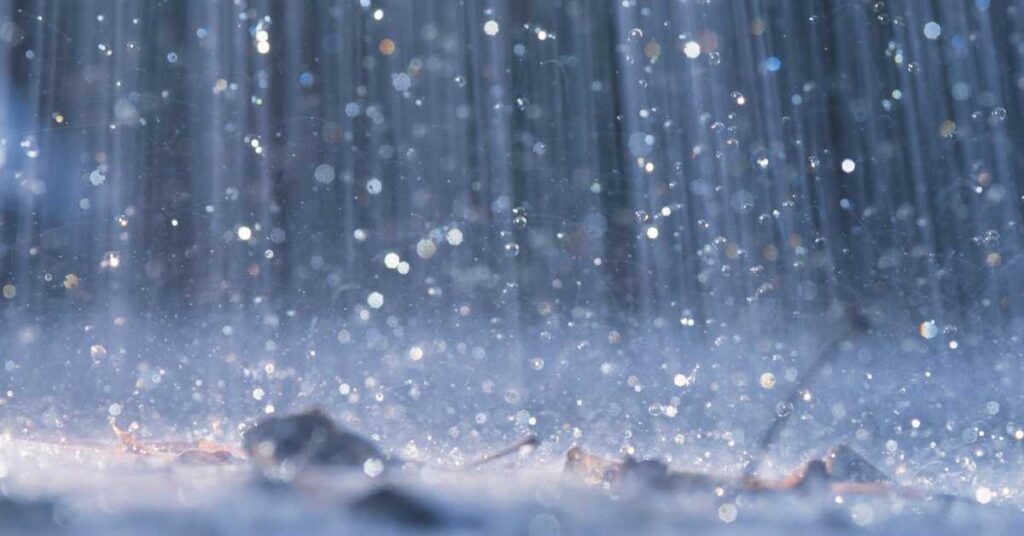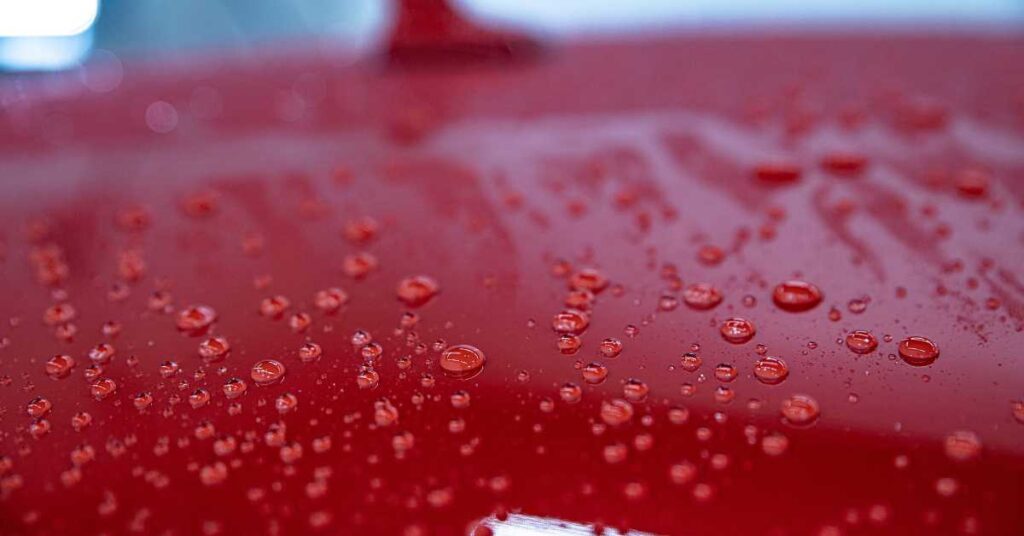What happens if it rains on fresh spray paint? If your freshly spray painted project gets rained on before the paint is dry it will most likely have to be painted again. Rain will cause imperfections in the paint job if the paint has been dried completely. You will have to access the damage and decide whether or not you will have to repaint the item.
Spray painting is a popular method of adding color and texture to surfaces, and it’s a great way to give your furniture, walls, or other items a fresh new look. However, unpredictable weather conditions can pose a challenge when it comes to spray painting. Rain, in particular, can have a significant impact on the quality of your spray paint job, and it’s essential to understand what happens if it rains on fresh spray paint.
If you’re wondering what happens if it rains on fresh spray paint, the answer is not a good one. Rain can cause a range of problems, including poor adhesion, bubbling, inconsistent color, and sheen levels. Additionally, if you try to apply paint to a wet surface, the paint won’t be absorbed, and you’ll be left with a messy, uneven finish. The good news is that there are steps you can take to prevent rain damage and ensure a smooth, professional-looking spray paint job.
Key Takeaways
- Rain can have a significant impact on the quality of your spray paint job, causing poor adhesion, bubbling, and inconsistent color and sheen levels.
- To prevent rain damage, it’s important to choose the right weather conditions for spray painting, including warm and dry or cold with low humidity levels.
- If rain does occur, it’s important to take immediate action to minimize damage, including covering the affected area and allowing it to dry thoroughly before attempting to repaint.

What happens if it rains on fresh spray paint?
If you’ve just completed a spray paint job and rain is in the forecast, you may be wondering what impact the rain will have on your fresh paint. While rain can be problematic for fresh paint, the extent of the damage will depend on several factors.
Potential Damage
Rain can cause significant damage to fresh spray paint. The water can cause the paint to run, leaving unattractive streaks on the surface. Additionally, the moisture can cause the paint to bubble or blister, leading to peeling or flaking.
If the paint has not fully cured, the rain can also cause the color to fade or change. This is because the water can dilute the paint, causing it to lose its vibrancy or change color entirely.
Quality Deterioration
If the fresh spray paint is exposed to rain, the quality of the paint can deteriorate. The paint may not adhere properly to the surface, leading to a shorter lifespan for the paint job. Additionally, the rain can cause the paint to age prematurely, leading to cracking or fading over time.
To prevent damage to your fresh spray paint job, it’s best to avoid painting when rain is in the forecast. If you must paint in less-than-ideal weather conditions, make sure to use a paint that is specifically designed to withstand moisture.
In conclusion, rain can have a significant impact on fresh spray paint. It’s important to take precautions to prevent damage to your paint job. By understanding the potential risks and taking steps to mitigate them, you can ensure that your paint job lasts for years to come.
Preventive Measures for Spray Painting in Unpredictable Weather
When it comes to spray painting, weather conditions play a crucial role in the outcome of your project. If it rains on fresh spray paint, it can ruin the finish and cause the paint to peel off. To avoid this, it is important to take preventive measures while spray painting in unpredictable weather.
Weather Forecast Check
Before starting your spray painting project, check the weather forecast for the next few days. If there is a chance of rain or high humidity, it is best to postpone your project until the weather improves. You can also use a weather app or website to monitor the humidity levels in your area. The ideal humidity level for spray painting is between 40 and 70 percent.

Use of Protective Covers
If you cannot postpone your project and need to spray paint in unpredictable weather, use protective covers to shield your work area from rain or moisture. You can use plastic sheets or tarps to cover your work area and protect it from rain. Make sure to secure the covers properly to prevent them from blowing away in the wind.
Additionally, you can also use protective covers to shield your painted surfaces from rain or moisture. If you have already painted a surface and are worried about rain, cover it with plastic or a tarp until the paint dries completely. This will prevent rain from ruining the finish and causing the paint to peel off.
In summary, spray painting in unpredictable weather can be challenging, but with the right preventive measures, you can avoid the risk of rain ruining your project. Check the weather forecast and use protective covers to shield your work area and painted surfaces from rain or moisture.
By taking these simple steps, you can ensure a successful spray painting project, regardless of the weather conditions.
Post-Rain Damage Control
Surface Assessment
After it rains on your freshly spray-painted surface, the first thing you need to do is assess the damage. Look for any visible signs of water damage such as discoloration, bubbling, or cracking. If the damage is minimal, you may be able to fix it with some light sanding and touch-up painting.
However, if the damage is severe, you may need to remove the paint completely and start over. This can be a time-consuming and costly process, so it’s important to take the time to properly assess the damage before making any decisions.
Repainting Process
If you’ve determined that the damage is minimal, you can begin the repainting process. Start by lightly sanding the affected area to remove any bubbling or cracking. Once the area is smooth, use a primer to prepare the surface for painting.
When selecting your paint, make sure to choose a high-quality spray paint that is specifically designed for the type of surface you’re painting. Apply the paint in thin, even coats, allowing each coat to dry completely before applying the next.
Once the final coat of paint has dried, you can apply a clear coat to protect the surface from future damage. Make sure to follow the manufacturer’s instructions for drying times and application methods.
In summary, rain on fresh spray paint can cause damage to your surface, but with proper post-rain damage control, you can fix the damage and prevent it from happening again in the future.
Additional Tips for Spray Painting in Various Weather Conditions
When it comes to spray painting, weather conditions can make a big difference in the outcome of your project. Here are some additional tips to help you achieve the best results in different weather conditions:
Hot and Dry Weather
In hot and dry weather, the paint can dry too quickly, leading to a rough and uneven finish. To avoid this, try to paint during the early morning or late afternoon when the temperature is cooler. You can also use a slower-drying paint or add a paint conditioner to extend the drying time.
Cold and Humid Weather
In cold and humid weather, the paint can take longer to dry, leading to drips and runs. To avoid this, try to paint indoors or in a well-ventilated area. You can also use a faster-drying paint or add a paint accelerator to speed up the drying time.
Windy Weather
In windy weather, overspray can be carried away, leading to uneven coverage and wasted paint. To avoid this, try to paint in a sheltered area or use a cardboard box as a makeshift spray booth. You can also use a fan or air compressor to help control the overspray.
Rainy Weather
In rainy weather, the paint can be washed away or diluted, leading to a ruined finish. To avoid this, try to paint indoors or in a covered area. If you must paint outside, wait for a clear day with low humidity and wind. You can also use a waterproof paint or add a paint sealer to protect the finish.
By following these additional tips, you can achieve a professional-looking finish no matter what the weather conditions may be.
Frequently Asked Questions
How long should I wait for spray paint to dry before it rains?
The ideal drying time for spray paint is usually 24 hours before it is exposed to any moisture, including rain. However, this can vary depending on the type of paint, the surface, and the weather conditions. Always check the manufacturer’s instructions for specific drying times.
Can rain damage fresh spray paint?
Yes, rain can damage fresh spray paint. Wet surfaces will make it difficult for the paint to adhere properly, and it may cause the paint to run or drip. Additionally, rain can cause water spots or discoloration on the paint surface.
What is the recommended drying time for spray paint before rain?
The recommended drying time for spray paint before rain is at least 24 hours. However, it is always best to check the manufacturer’s instructions for specific drying times. If rain is in the forecast, it is best to wait until the weather clears up before spray painting.
Will rain cause spray paint to run or drip?
Yes, rain can cause spray paint to run or drip. Wet surfaces will make it difficult for the paint to adhere properly, and it may cause the paint to run or drip. Additionally, rain can cause water spots or discoloration on the paint surface.
What should I do if it starts raining while I’m spray painting?
If it starts raining while you are spray painting, stop immediately and move the project indoors or to a covered area. If you cannot move the project, cover it with plastic sheeting or a tarp to protect it from the rain. Wait until the rain has stopped and the surface is completely dry before continuing with the project.

How can I protect my spray paint from rain damage?
To protect your spray paint from rain damage, always check the weather forecast before starting your project. If rain is in the forecast, it is best to wait until the weather clears up before spray painting. If you cannot wait, move the project indoors or to a covered area. Additionally, you can apply a clear coat or sealant to the surface to help protect it from moisture.
Final Thoughts
In conclusion, it is important to avoid painting in rainy or humid conditions, as it can significantly impact the quality of your paint job. If you must paint in less-than-ideal conditions, we recommend taking the necessary precautions to protect your work from the elements.
Remember to always check the weather forecast before starting any painting project and plan accordingly. If rain is in the forecast, it is best to delay your project until the weather improves.
Additionally, ensure that you are using the appropriate paint for the surface you are painting on, especially if it will be exposed to the elements. Using exterior paint with additives that help it withstand the elements will ensure that your paint job lasts longer and is more resistant to damage from rain.
By following these simple guidelines and taking the necessary precautions, you can ensure that your paint job is not ruined by rain.

